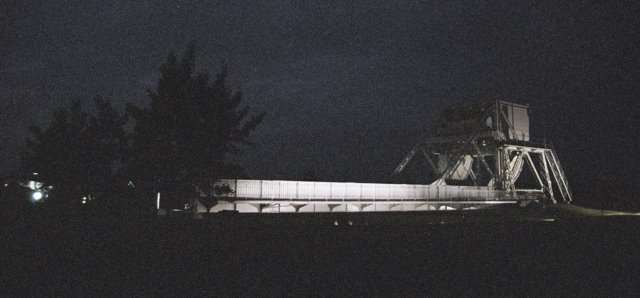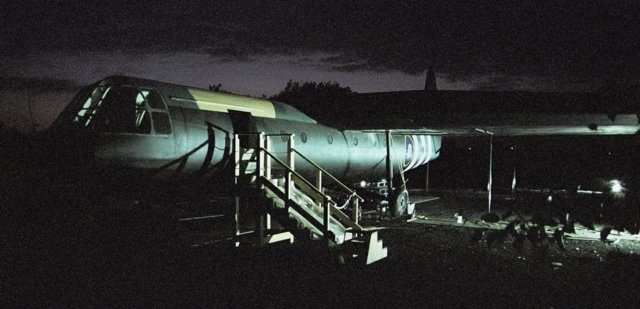The Horsa glider coup-de-main landings in Sicily and Normandy are umbilically linked. The one gave birth to the other. Glider pilot Jim Wallwork, justly remembered for his extraordinary feat at Pegasus Bridge, was also present in Sicily, although with somewhat different results.

The time: two hours before midnight, the 5th of June, 2004, on the eve of the 60th anniversary of the D-Day landings. The place: Benouville, a hamlet on the river Orne, in Normandy, France. Outside the Cafe Gondree, next to the bridge, a packed crowd of revellers is drunkenly singing old war songs such as ‘It’s a Long Way to Tipperary’. Nearby, French technical students are frantically putting the final touches to a full-size replica of a glider. It bears the markings of one of three gliders full of troops that were sent here to seize this bridge during the opening moments of D-Day. French motorcycle police with machine guns are trying to get the students to go home. For tomorrow Prince Charles is coming here to meet Jim Wallwork, the pilot of that glider, and the police want no loose ends. Normandy is being locked down tighter than it was on D-Day itself, in anticipation of a mass invasion by tourists and terrorists. Before he shuts the gate behind the last volunteer, the students’ supervisor checks both ways for patrolling policemen, and then kindly lets me in to take a photograph:

Now wind back the clock 60 years, to just after midnight, the 6th of June, 1944. Six miles from its target, Jim Wallwork’s glider bucks as he releases the tow cable. As the roar of the tug plane’s engines fade into the distance, the 30 heavily armed men sitting behind him fall silent. Using only a stopwatch and compass, ignoring the moonlit landscape below, he flies by the numbers. The river shines like a mirror in the darkness. Making a last turn, he suddenly sees the field right in front of him. He’s coming in too fast. A drag chute snaps open for two seconds, then it’s gone. The glider tears along the ground, bouncing, smashing, sparks flying from barbed wire entanglements. The nose ploughs into the end of the field and the cockpit disintegrates. Wallwork is thrown through the air. He passes out.
Wind back the clock again, this time by 11 months, to July 1943. The place: Syracuse, Sicily. The Allied invasion of Italy begins with Operation Ladbroke, a night glider drop to capture a vital bridge near that ancient town. Wallwork’s tug plane is hopelessly lost. It has been towing his glider up and down the coast of Sicily now for what seems like hours. Finally it casts him off. He lands 56 miles from the bridge. He and his men start walking.
The landings are a disaster. Only one glider lands intact near the bridge. There is only one stills photograph and a little cine footage of Operation Ladbroke gliders among all the rolls of film from Sicily now in the Imperial War Museum, and they are of this lone glider. Is this because this glider is the sole spectacular success, and official war photographers are not meant to commemorate what might look like failure?
Of the other gliders, over half land in the sea, and many soldiers drown. Others gliders disintegrate against cliff faces or stone walls, others blow up on landing. One reputedly assaulted the wrong Mediterranean island, Malta. Back in Sicily, only about 10% of the force, a dozen or so gliders, land on or vaguely in the vicinity of their landing zones south of the bridge. The surviving men capture it and hold the bridge, for some 16 hours, before it’s recaptured by Italian forces. Winston Churchill, Prime Minister at the time and staunch proponent of the invasion of Sicily, later called it “a forlorn feat of arms”.
An analysis of the operation was conducted afterwards, and many lessons learned. Not enough lessons perhaps, because nearly a year later, on D-Day in France, many gliders also went wildly astray in the darkness. Not Jim Wallwork’s, however, despite, or perhaps precisely because he had missed his target in Sicily by 56 miles.
Now wind the clock forwards those 11 months, back to that midnight where we left Jim Wallwork lying unconscious in a French field. He has landed his glider exactly where he was supposed to, just yards from the bridge in Benouville. His passengers storm out of the glider and seize the bridge. Here is the scene. This impressive piece of precision parking will be later described by an Air Chief Marshal as “the greatest feat of flying of the Second World War”.
For the final time, let’s wind that clock – this time forwards 60 years, back to where our story began, on the anniversary of D-Day in 2004. In the great heat of a perfect June day, Prince Charles and Jim Wallwork swelter in the cockpit of the replica glider. As they emerge, journalists bombard them with questions. Wallwork is reticent and plays down his role. Was it the greatest feat of flying? No, he says – his crash-landing simply “took out the barbed wire so the fellows dashing out wouldn’t tear their trousers.” He seems reluctant to say more. After 60 years of telling, this story ends here.
Read a fuller account of the 2004 60th anniversary of D-Day celebrations here.

“There is only one photograph of a glider among all the rolls of film from Sicily now in the Imperial War Museum, and this is it. Is it the only one because the official war photographers were not meant to commemorate failure?”
No it is because of lack of AFPU men. This (Horsa) glider is photograped near ponte Grande bridge by Capt. Fletcher AFPU . He lost most of his equiptment on landing with the South Staffords. An other AFPU sgt Bowers was suposed to go with the paratroops but this operation was canceled and he went in by glider that dissapeared.
Sgt Spittle AFPU went unfit just before the operation and Fred Bayliss of Paramount News was killed on route before the operation.
Recently some footage turned up of the Ponte Grande brideg were you can see the glider from an other angle.
Thanks very much for your comment Jim.
It was me that discovered the new footage and first published it, and then told its story and the story of the glider cameramen in my posts:
New footage of Horsa found
The story of the glider cameramen
I’ve updated the text above that you’ve highlighted to reflect the discovery of the new footage.
The famous stills photograph of the Horsa that has been in circulation for many years was not taken by Fletcher, but by Geoffrey Keating, one of the stars of the AFPU, who came by sea (see Alan Whicker’s book for more on Keating).
Many AFPU cameramen arrived with the seaborne forces, and there were many wrecked gliders in the area. The fact remains that these AFPU men did not take a single known shot of another Operation Ladbroke glider, despite what must have been plentiful opportunities.
The SAS troops who landed on the Maddalena Peninsula did take photos of landed Wacos, as you might expect – after all, they were a remarkable if sorry sight.
The Americans also took many photos of British Wacos – see my post: American camera crew film gliders
So it’s still a mystery why all those British official cameramen ignored the gliders while the SAS and the Americans didn’t.
Ian
Got any information on tyhe missing glider of Horsa Bridge that landed 5 miles off target near a bridge over the Dives river just south of Cabourg?
Erik
Thanks for asking Erik, but that’s not my area of expertise. You could try asking the GPRS Facebook group.